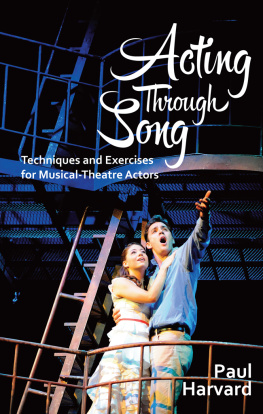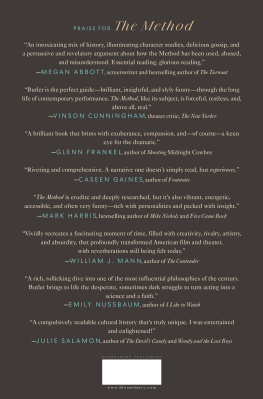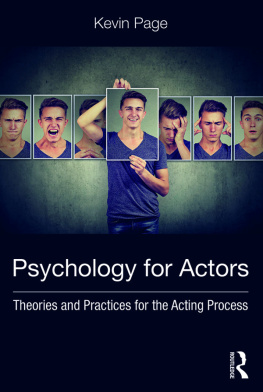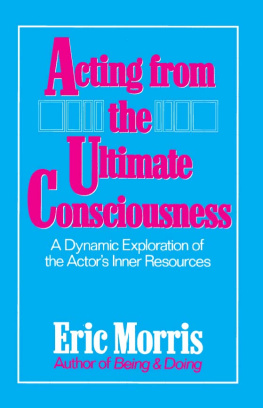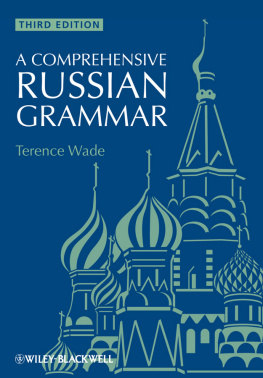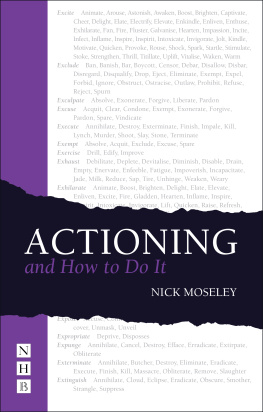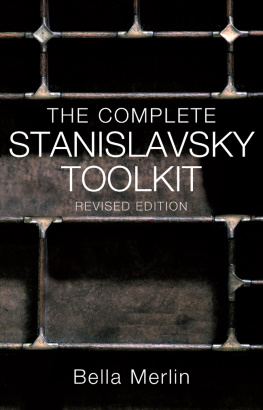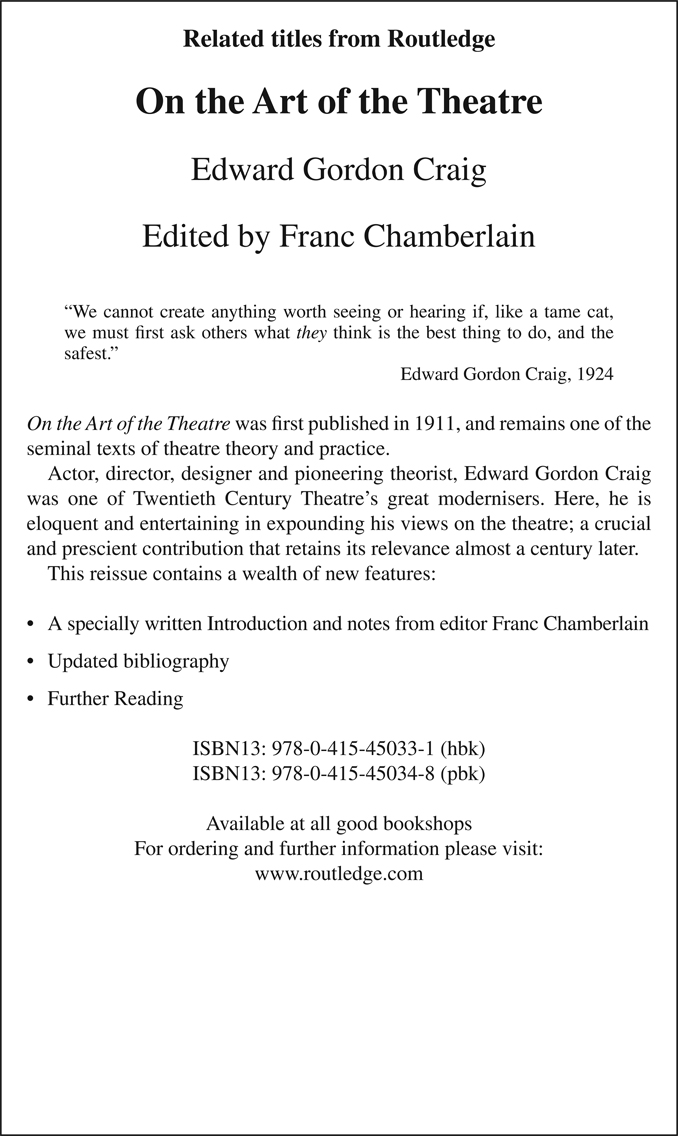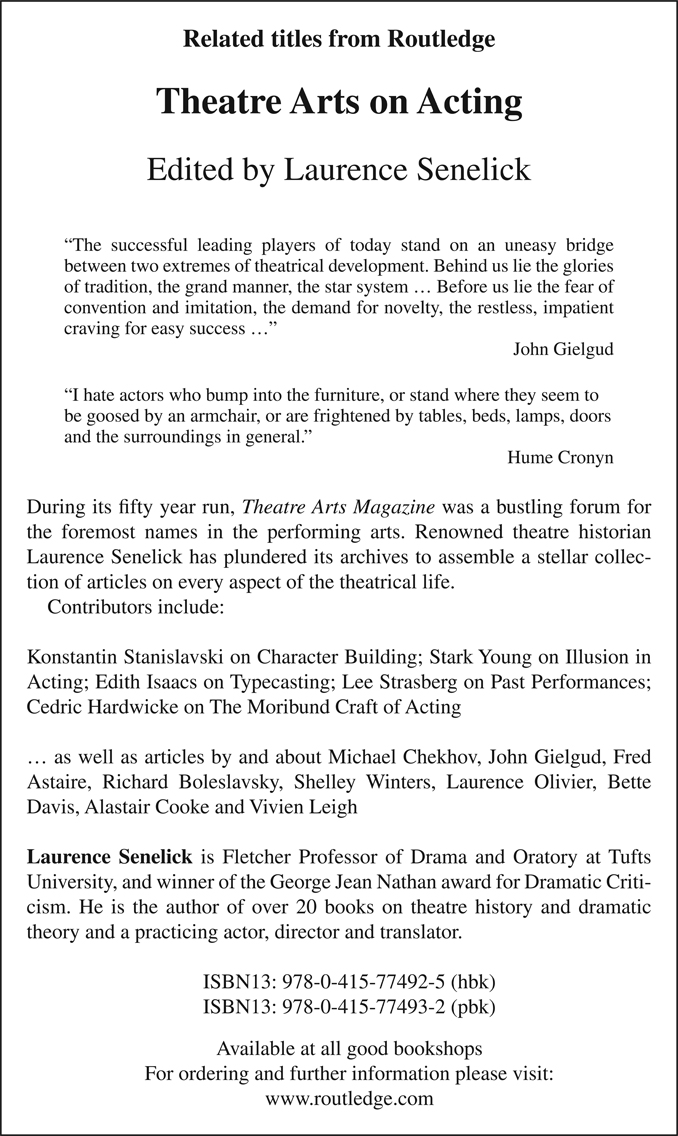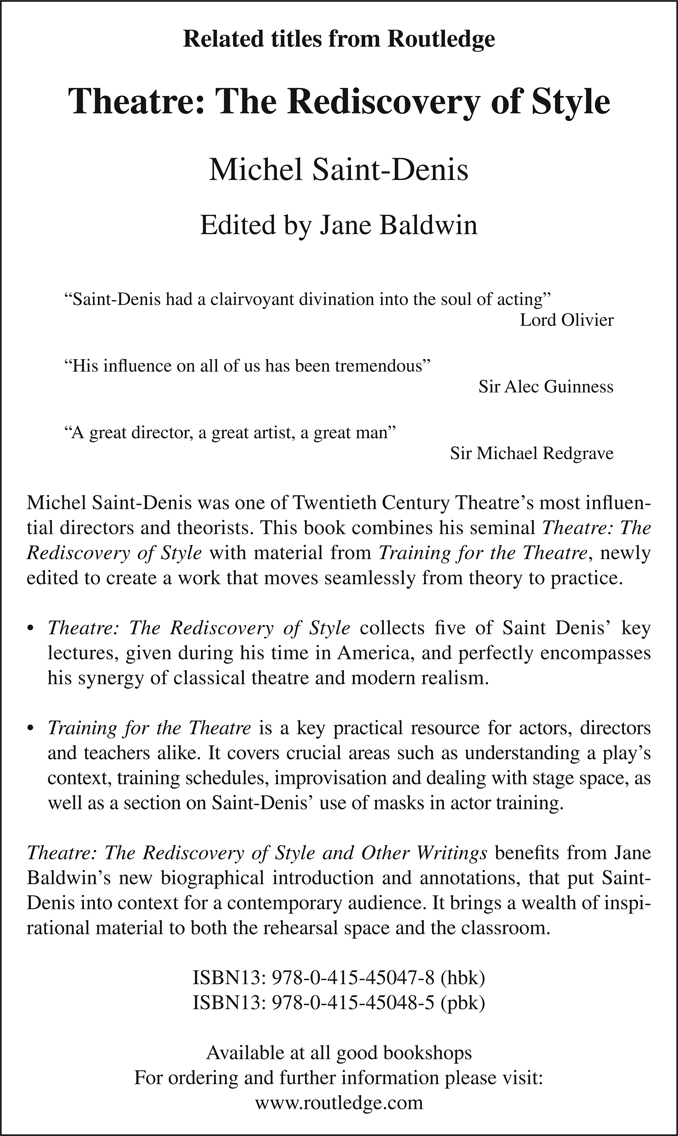For the second edition
When Talia Rodgers of Routledge suggested that I revise this book for a second edition, I felt honored, first, by the press that had acquired it in 2002 and, second, by my readers (actors, directors, students, and scholars alike) who have kept it in print for a decade. I consider the wonderful responses that I have received from my readers as my truest awards. As recently as 27 March 2007, a new reader emailed me to say that my book is a very motivating work; it not only talks about the tension between praxis and theory of theatre, but demonstrates it at the same time (Matt Foss, graduate student, Wayne State University). He puts his finger on what I most hope to do in all my work: to bridge the gap between acting practice and scholarship.
I heartily thank Talia Rodgers for her support, her staff at Routledge (especially Ben Piggott) for facilitating the editorial process, and the Taylor and Francis Editorial Board. I am deeply indebted to Anne Bogart, Andr Gregory, and Ed Hooks for so generously endorsing my book. In addition, I warmly thank all my readers, colleagues and friends who have contributed to this new edition: Bella Merlin and David Chambers (Yale University) for helpful comments on the revision plan; R. Andrew White (Valparaiso), Sarah Dixon, and Mary Joan Negro for reading key revisions and offering valuable suggestions; Rhonda Blair (Southern Methodist University) and Cheryl McFarren for input on the Systems relationship to psychology and cognitive science; Lisa Wolford Wylam (York University) and Setrak Bronzian for encouragement; Phillip G. Bennett, director David Kaplan, Ellen Gainor (Cornell), Norman Schwartz, and two former members of the Moscow Art Theatre, Eugene Lazarev and Maria Ignatieva (Ohio State University at Lima), for valuable and pertinent conversations; Richard Kramer for his detailed corrections; and Lou Catron for promoting my book to young thespians. I also acknowledge my insightful B.A. students at the University of Southern California and the professional actors who work with me on Active Analysis in my weekly A/ACT Workshop.
This edition would not have seen the light of day without the assistance of Anatoly Smeliansky (The Moscow Art Theatre) and Ruth Wallach (University of Southern California Libraries) who obtained crucial materials for me from Russia; Azneve Bronzian who generously volunteered to help me with bibliographic reformatting; Prakash Shirke (University of Southern California) and the wonderful staff of the New York Public Library (in both Permissions and Research Collections).
Finally, my acknowledgements from the first edition (below) are as sincerely meant today as they were in 1998.
For the first edition
My research on Stanislavsky and Strasberg was funded by the American Council of Learned Societies, the National Endowment for the Humanities, and a Rockefeller Residency Fellowship at the Wisconsin Center for Film and Theater Research (an Archive of the University of Wisconsin, Madison, and the State Historical Society of Wisconsin). During my residency in Wisconsin, Donald Crafton (Director), Maxine Fleckner Ducey (Film Archivist) and George Talbot (Curator of the Visual and Sound Archives) offered me invaluable help. The University of Southern California provided me with much needed sabbatical leave to complete the writing of this book.
The Moscow Art Theatre, the former USSR Theatre Union, and the Art Center (Moscow) facilitated visits to Moscow. I am especially grateful to Anatoly Smeliansky (The Moscow Art Theatre), Inna Solovyova (The Moscow Art Theatre School and the Russian Academy of Theatrical Arts), and Vladimir Dybovsky for sharing their research and ideas with me. I also thank Tina Andronikashvili (The International Center for Stanislavsky Studies, Moscow), playwright Aleksander Buravsky, actress Louisa Mosends, and Vladimir Prudkin (Artistic Director, Art Center) for their hospitality while I was there.
I am indebted to Michael Heim (University of California, Los Angeles) who generously allowed me access to notes he took in Moscows archives, John von Knorring (Stylus Publishing, Inc.), Laurence Senelick (Tufts University) for his insightful comments on the typescript, Jean Benedetti (London) for his suggestions and ideas about the System and its terminology, David Hapgood, Norris Houghton and Helen Krich Chinoy for their reminiscences, Allison Comins-Richmond for her research assistance, Cynthia Baron, Ritchie Spencer, Setrak Bronzian and all my friends and colleagues for their encouragement. I acknowledge Howard Schmitt for assistance with photography, and Allen Carnicke and Kathy Lindbeck for their help with computers.
There are many others without whose inspiration and support I would never have been able to write this book: Bernard Beckerman (Columbia University), Travis Bogard (University of California, Berkeley), Aaron Frankel (Columbia University and H. B. Studios), Sam Tsikhotsky (The Moscow Art Theatre), the teachers at the Moscow Art Theatre School and the Russian Academy of Theatrical Arts (especially Natalia Zverova and Leonid Kheifets) who unhesitatingly invited me into their classes, those participants in the Americanization of StanislavskyLee Strasberg, Robert Lewis, Stella Adler, Harold Clurmanwhom I was fortunate to meet, and finally the actors of A/ACT in Hollywood who allow me the opportunity to experiment with acting every week.
- LActors Studio. (1989) Panel discussion at the International Symposium, Le Sicle Stanislavski, Centre Georges Pompidou, Paris, 4 November 1989.
- Adler, Stella (1988) The Technique of Acting, New York: Bantam Books.
- The American Laboratory Theatre (192425) Catalogue, New York.
- Archer, Jules (1975) The Russians and the Americans, New York: Hawthorn Books.
- Autant-Mathieu, Marie Christine (2003) Stalin and the Moscow Art Theatre, Slavic andEast European Performance, 28(3):7085.
- (2005) Systme et contre-systmes, in Stanislavski, Tchekhov, Paris: ARIAS:2933.
- Balukhatyi, S. D. (1927) Problemy dramaturgicheskogo analiza: Chekhov, Leningrad: Academia.
- Barthel, Joan (1975) The Master of the Method Plays a Role Himself, The New York Times (February 2).
- Beckerman, Bernard (1970) Dynamics of Drama: Theory and Method of Analysis, New York: Alfred A. Knopf.
- Beckwith, Sarah (1993) Christs Body: Identity, Culture and Society in Late Medieval Writings, New York: Routledge.
- Benedetti, Jean (1982) Stanislavski: An Introduction, New York: Theatre Arts Books.
- (1990a) A History of Stanislavski in Translation, New Theatre Quarterly, 23:26678.
- (1990b) Stanislavski: A Biography, New York: Routledge.
- (1998) Stanislavski and the Actor, New York: Routledge.
- Bentley, Eric (1962) Who Was Ribot? Or Did Stanislavsky Know any Psychology? Tulane Drama Review, 7(2):1289.
- Birman, Serafima (1959) Put aktrisy, Moscow: VTO.
- Bjornage, Kjeld (1989) Remarks at the International Symposium, Stanislavsky in a Changing World, USSR Theatre Union, Moscow, 9 March 1989.
- Blair, Rhonda (2006) Image and Action: Cognitive Neuroscience and Actor Training, in Bruce McConachie and F. Elizabeth Hart (eds),



